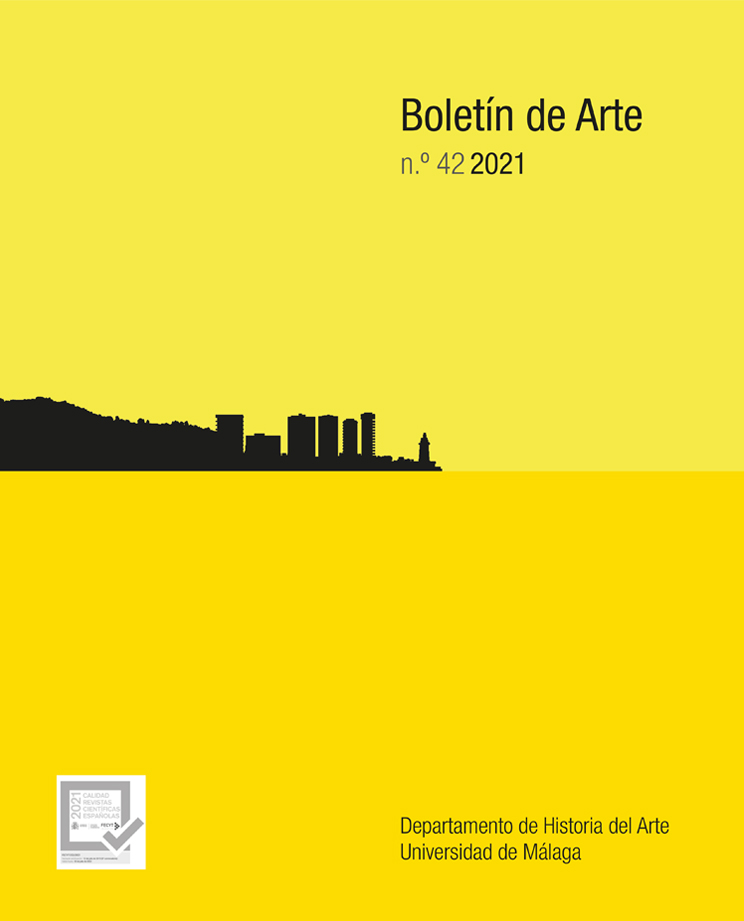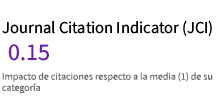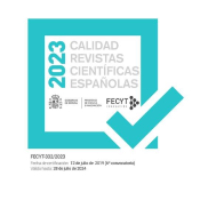The Diversity of Oriental Ideals: a Re-reading of Asian Unity in the Work of Okakura Kakuz? from the Indian Perspective
DOI:
https://doi.org/10.24310/BoLArte.2021.vi42.8145Keywords:
Okakura kakuz?, Rabindranath Tagore, Artistic theory, Pan-Asianism, Originality, Tradition, Bengal SchoolAbstract
This paper proposes new nuances in the interpretation of Okakura Kakuz?’s work The Ideals of the East (1903) using Bengali theoretical sources linked to artistic pedagogy. The interaction of Okakura Kakuz? with the cultural elites of Calcutta led to the writing of that book, but also to the implementation of a cultural twinning relevant to the study of artistic modernity in Asia. This article breaks down the ideological unity of Asia proposed by Okakura and the Bengali theorists with the intention of showing the main Western theoretical sources used in the construction of the Asian unitary ideal. The purpose of this article is to provide already consolidated clues in Indian anticolonial artistic theory to interpret Okakura’s text in a more open key.
Downloads
Metrics
References
BHARUCHA, Rustom (2010), Another Asia. Rabindranath Tagore & Okakura Tenshin, Oxford University Press, Nueva Delhi.
CHAKRABARTY, Dipesh (2008), Al margen de Europa. Pensamiento Postcolonial y diferencia histórica (tr. de Alberto Álvarez y Araceli Maira), Tusquets, Barcelona.
CHATTERJEE, Partha (2011), Nationalist thought and the Colonial World. A derivative discourse, University of Minnesota Press, Minneapolis.
CLARK, John (2005), «Okakura Tenshin and Aesthetic Nationalism», East Asian History, n.º 9, pp. 1-38.
COOMARASWAMY, Ananda K. (1910), «About pictures», The Modern Review, vol. VIII, n.º 5 (pp. 523-524) y n.º 6 (pp. 592-594).
COOMARASWAMY, Ananda K. (1918), The Dance of ?iva. Fourteen Indian Essays, The Sunwise Turn, Nueva York.
COOMARASWAMY, Ananda K. (1980), La filosofía cristiana y oriental del arte (tr. de Esteve Serra), Taurus, Madrid.
COOMARASWAMY, Ananda K. (1981), Essays in National Idealism, Munishram Manoharlal, Nueva Delhi.
COOMARASWAMY, Ananda K. (1996), La danza de ?iva. Ensayos sobre arte y cultura india (ed. Eva Fernández del Campo), Siruela, Madrid.
COOMARASWAMY, Ananda K. (1997), La transformación de la naturaleza en arte, Kairós, Barcelona.
DEPARTMENT OF HISTORY OF ART (KALABHAVANA) (1979), «Kala-Bhavana - Then and Now. A Special Issue», Nandan. An Annual on Art and Aesthetics.
FERNÁNDEZ DEL CAMPO, Eva (2013), Los cánones del arte indio, Abada, Madrid.
FERNÁNDEZ GÓMEZ, Rosa (2008), «La estética invisible del arte popular», Contrastes, Revista Internacional de Filosofía, suplemento 13, pp. 41-54.
GUHA-THAKURTA, Tapati (2008), The Making of a New ‘Indian’ Art. Artists, Aesthetics and Nationalism in Bengal, c.1850-1920, Cambridge University Press, Cambridge.
GUHA-THAKURTA, Tapati (2009), «Dialogues in Artistic Nationalism», Art India. The Art News Magazine of India, vol. XIV, n.º 3, pp. 22-43.
GUTH, Christine M. E. (2000), «Charles Longfellow and Okakura Kakuz?: Cultural Cross-Dressing in the Colonial Context», Positions, vol. 8, n.º 3, pp. 605-636.
HAY, Stephen N. (1970), Asian Ideas of East and West. Tagore and his critics in Japan, China and India, Harvard University Press, Cambridge (Mass.).
LAGO, Mary M. (ed.) (1972), Imperfect Encounter. Letters of William Rothenstein and Rabindranath Tagore, 1911-1941, Harvard University Press, Cambridge (Mass.).
MAILLARD, Chantal y PUJOL, Óscar (1999), Rasa. El placer estético en la tradición india, Indica Books, Varanasi.
MITTER, Partha (1994), Art and Nationalism in Colonial India, 1850-1922. Occidental orientations, Cambridge University Press, Cambridge.
MITTER, Partha (2007), The Triumph of Modernism. India’s artists and the avant-garde, 1922-1947, Reaktion Books, Londres.
NAGAHIRO, Kinoshita (2012), «Okakura Kakuz? as a Historian of Art», Review of Japanese Culture and Society, vol. 24, n.º 1, pp. 26-38 (DOI: 10.1353/roj.2012.0010).
NINOMIYA-IGARASHI, Masumi (2010), Drawn toward India: Okakura Kakuz?’s Interpretation of Rájendralála Mitra’s Work in his construction of Pan-Asianism and the History of Japanese Art (tesis doctoral), University of North Carolina.
NOTEHELFER, F. G. (1990), «On Idealism and Realism in the Thought of Okakura Tenshin», Journal of Japanese Studies, vol. 16, n.º 2, pp. 309-355.
OKAKURA, Kakuzo (1905), The Ideals of the East, with special reference to the art of Japan, John Murray, Londres.
OKAKURA, Kakuzo (2018), Los ideales de Oriente: con especial referencia al arte japonés (tr. de Fernando Álvarez), Satori, Gijón.
RAY, Satyajit (1993), Our Films, Their Films, Longman, Calcuta.
ROMÁN, Sergio (2013), «La enseñanza del arte en Santiniketan como punto de encuentro de Japón y Europa bajo el amparo ideológico de Rabindranath Tagore», en GARCÉS GARCÍA, Pilar y TERRÓN BARBOSA, Lourdes (eds.), Itinerarios, viajes y contactos Japón-Europa, Peter Lang, Berna, pp. 787-795.
RUSKIN, John (1903), Modern Painters, vol. II (Of the Imaginative and Theoretic Faculties), George Allen, Londres.
SAMANTA, Sri Kanai (1982), «Nandalal Bose on Art», Visva-Bharati News (Nandalal Bose Centenary Number 1882-1982), pp. 4-17.
SHEIKH, Gulam Mohammed, SUBRAMANYAN, K. G., VATSYAYAN, Kapila (1984), Paroksa. Coomaraswamy Centenary Seminar Papers, Lalit Kala Akademi, Nueva Delhi.
TAGORE, Abanindranath (1944), Jo??s?n?kor Dh?re, Kalik?t?, Bi?vabh?rat? Granth?la?a.
TAGORE, Rabindranath (1929), «The Philosophy of Leisure», The Visva-Bharati Quarterly, vol. VII, n.º 1, pp. 5-12.
VATSYAYAN, Kapila (1984), «Nature, Tradition and Originality: A Paradigm for Art Historical Study», The Visva-Bharati Quarterly, vol. 49, n.º 1-4, pp. 142-163.
Downloads
Published
How to Cite
Issue
Section
License
Todos los contenidos publicados en la revista Boletín de Arte están sujetos a la licencia Creative Commons Reconocimento-NoComercia-Compartirigual 4.0 cuyo texto completo puede consultar en <http://creativecommons.org/licenses/by-nc-sa/4.0>

Los/as autores/as cuyas contribuciones sean aceptadas para su publicación en esta revista conservarán el derecho no exclusivo de utilizar sus contribuciones con fines académicos, de investigación y educativos, incluyendo el auto-archivo o depósito en repositorios de acceso abierto de cualquier tipo.
La edición electrónica de esta revista esta editada por la Editorial de la Universidad de Málaga (UmaEditorial), siendo necesario citar la procedencia en cualquier reproducción parcial o total.











4.png)
